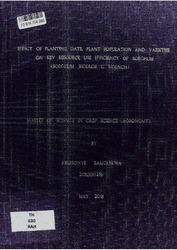| dc.description.abstract | Inappropriate selection of planting date, plant population and varieties choice have a negative impact on the efficient use of resources and yield returns resulting in some challenges that affect crop production. The experiment was carried out between January and June 2016 at Botswana University of Agriculture and Natural Resources (BUAN) Farm at Sebele to evaluate the effect of planting date, plant population and varieties on nitrogen use efficiency (NUE) and rainwater use efficiency (RWUE) of sorghum (Sorghum bicolor (L) Moench. A 2*3*4 factorial experiment was conducted in a split-split randomized block design with three treatments that were replicated four times. The main plot was the two-planting date- factor A (January and February), the sub plot was four plant populations (factor B) and the sub-sub plot were three sorghum varieties - factor C (Segaolane, PSL985050 and PSL985028). Data was collected on growth parameters, biomass and RWUE-at vegetative, booting,. flowering and physiological maturity, grain yield (Gy) and its components; Nitrogen Use Efficiency (NUE) and grain rain water use efficiency.
Data collected were affected by planting date causing a highly significant (P<0.0001) impact on biomass, RWUE, grain yield and NUE and its components.. Late planting date resulted in reduction in biomass, RWUE, grain yield, NUE and its components which have been triggered by shorter day length and reduction in temperatures. Reduction in Gy and its components was observed as plant population decrease due to few plants per unit area. Increase in plant population led to decline in RWUE at different growth stage except in the vegetative stage. Regarding NUE and its components (uptake and utilization efficiency), high population lowered the nitrogen uptake and utilization hence reduction in efficient use of nitrogen due to interplants competition., T(RWUEgy) were assessed at harvest. Different varieties varied significantly) at P<().()O()I for G) where Segaolane produced the highest yield of 234kg/ha at highest plant population as compared to PSI.985050 and PSL985028. A significant di (Terence of P<0.0I and P<0.()5 was observed among varieties on RWUE at different stages as well as RWUEgy. Segaolane had the highest RWUEGy of 1.01 kg/ha/mm as compared to PSL985050 and PSL985028. Given the y yield components, panicle length and panicle weight differ significantly at P<0.0001; P<0.01 respectively among varieties. Nitrogen uptake and utilization efficiency differ significantly (P<0.05) among the varieties while a highly significant difference (PO.OOOl) was noted for NUE. The highest NUE 9.38kg/ha was recorded for Segaolane and the lowest NUE of 2.9 recorded for PSL985050. Strong and significant correlations were observed between RWUE &. Gy, RWUE & NUE, and Gy & NUE. Therefore Segaolane, January planting date and medium low density are highly recommended for farmers in these changing climatic conditions which are threatening the agricultural sector in Botswana. | en_US |

